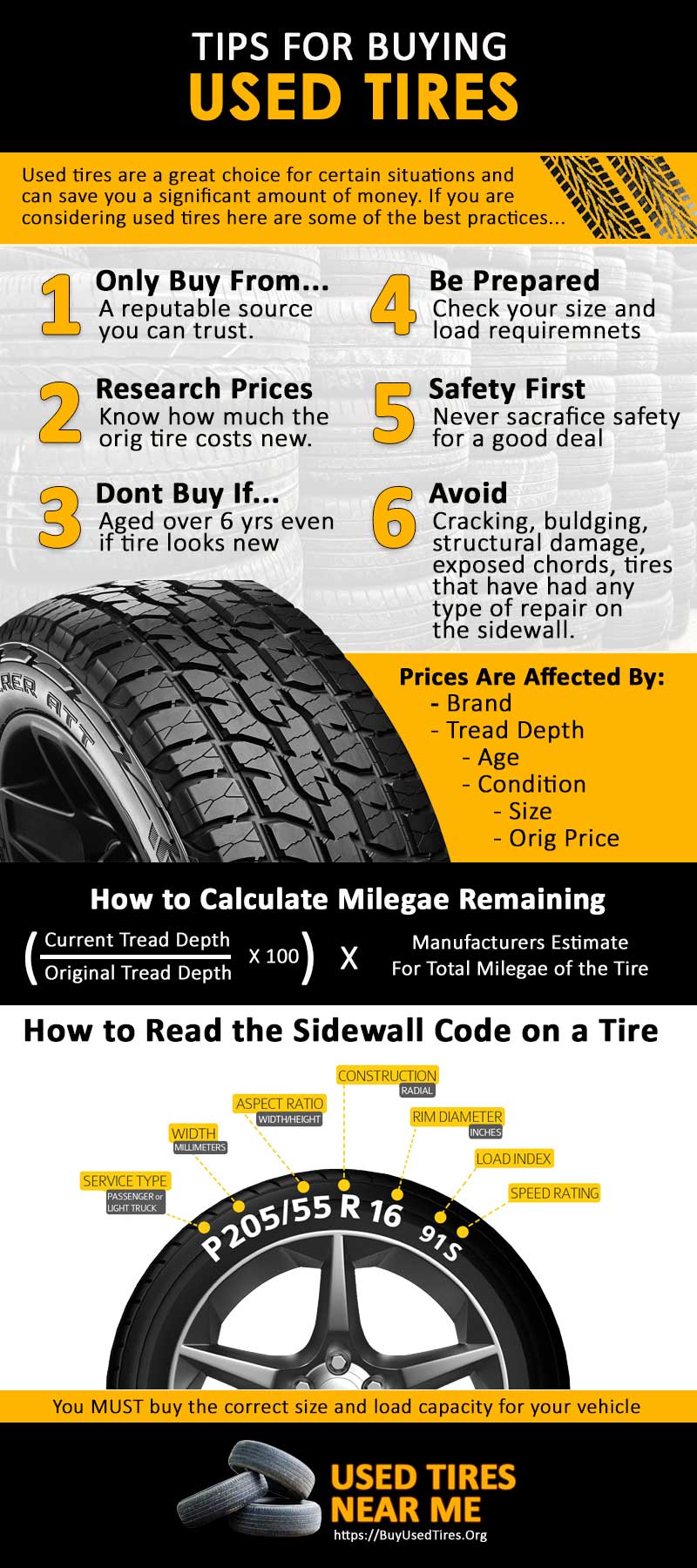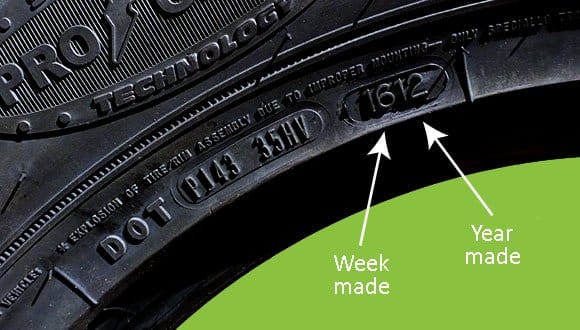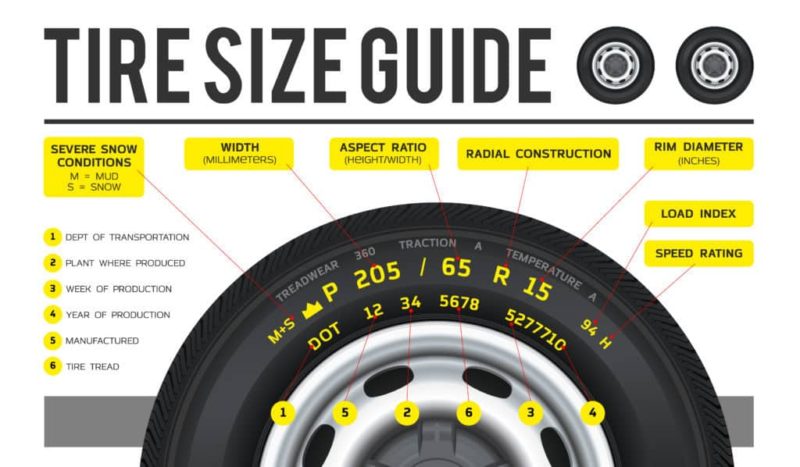Buying used tires is a great way to save money if you can find a good value tire with a lot of mileage left on it. More importantly though you need to evaluate if the used tire is safe. Today we are going to discuss a few tips for buying used tires. You will learn about how to figure out the remaining mileage, what affects the rice of a used tire, and how to evaluate a used tire for safety.
First let’s start with the basics and then we will dive into each piece of the infographic below.
6 Tips for Buying Used Tires
Now that we have the general idea of what goes into buying used tires, let’s deep dive on the topic…
1. Only Buy Used Tires From a Reputable Source
There are a lot of businesses that sell used tires, but not all of them are places who should purchase from. Certain businesses like salvage yards don’t really care about the tires you want to buy. If you want to buy bald tires they will sell them to you. The problem with the used tire business is there is limited government regulations and nothing to really stop someone from selling you a legally bald tire. If you don’t believe me, check out the most common used tire scams.
The best way to combat this is to only buy from a reputable source. You can trust your regular tire shop, used tire wholesale supplier, or auto mechanic if you have a relationship with them. If you don’t have relationships, my best advice is to thoroughly read reviews before you decide where to buy from. If you buy locally you can evaluate the used tire for safety yourself and ask for some guidance from the sales clerk. When you buy online you can look at metrics on tread depth, tire grades, and even compare the saving to the original manufacturers price. No matter what it’s important to buy from someone or somewhere you trust. Your safety depends on it.
2. Research The Original Price and The Manufactures Mileage Estimation
There are two aspects to price that we feel are important to consider when buying used. First is the original brand new price of the tire and second is the used price of the tire.
If a new Goodyear Eagle RS-A – Size: P265/50R20 was $300 new and the used one is half the cost at $150, you need to know how much tread wear is left. By the scenario presented, you might assume half the cost equals half the tread ware, but that’s not normally the case. There are multiple factors that affect the price including the original price, the brand, tread depth, age of the tire, and the size. Its not an exact science of how the price relates to the tread depth. In general used tires should save you 30 to 50% of the original price.
Not only should research the original price, but you should research the tread depth and mileage for the tire estimated by the manufacturer. This will help you determine if you are buying a good tire and figure out how long it will last. In general you can expect to get a used tire with 40%-70% of tread left, which should mean it has a lot of driving mileage left on it. Almost all the top tire manufacturers publish these numbers and you can find them on their websites.
3. Never Buy a Tire That is 6 or More Years Old
Even if a brand new tire, never driven on was being offered to me and it was 6 or more years old, I would n’t buy it. It is not safe!
After 6 years the chemicals used to make the rubber start to break down and become unstable. This cause the tire to crack, rot, and become brittle. Some places will not disclose how old a tire is unless you specifically ask.
To find the age of a tire, you must read the date on the sidewall. Look for the letters DOT. The numbers are raised and often represented in an oval shape. The first two numbers are the week the tire was made. The second two numbers are the year the tire was made. In the example it is 1612. This tire was made the 16th week of 2012.
If the date is over 6 years…pass on that tire. I don’t care what it looks like. It is not safe.
4. Be Prepared By Knowing Your Vehicles Size and Load Capacity Requirements
You can’t just go and buy any old used tire. When purchasing any tire, new or used, it must meet the minimum size and load capacity (load index) requirements for your vehicle. Additionally it should match the other tires size and load capacity on the vehicle.
To find your vehicles size and weight requirements there are 4 places you can check for this information
- Driver side door jam sticker
- Owners Manual
- Check the internet for your Vehicles requirements
- Check the sidewall code on the other tires on the vehicle.
It is NEVER safe to put a tire on your vehicle that isn’t the correct size and have the correct load index. When buying used tires, some sales people won’t tell you if you are buying the wrong tire. Be prepared to look yourself and double check that you have selected exactly what you need.
For more info read our article on understanding tire basics.
5. When Buying Used Tires Never Choose Price Over Your Safety
The most common reason people buy used tires is to save money. Safety becomes an afterthought. According to the NHTSA, there were 738 total motor vehicle traffic fatalities in the US in 2017 from tire related crashes.
Tires are the single most important safety feature on your vehicle. They are the contact point between you and the road. The less tread wear a tire has, then the longer your braking distances becomes and the less traction you have in wet conditions. Consider the safety and stability first when buying used tires. Consider the cost second. If you wreck because of the quality of the tire its going to cost you 100X more then buying a higher quality tire.
6. Avoid Buying Used Tires With Any Flaws
Read our article on how to evaluate a used tire for safety issues.
Here are the basics:
Roll the tire and make sure it rolls even and straight. Rub your hand along the sidewall and feel for bumps. Check the tread depth and ensure there is a reasonable amount remaining. Visually inspect the tire for rotting, chords poking out, bulging on the sidewall, repairs made on the sidewall, or structural damage.
Buying Used Tires Conclusion
Buying used is a great choice to save money and get a product that has a lot of life left in it. Its critically important to follow the tips above when buying tires used. Your life and your families life depends on it.
There are many reasons good quality used tires end up on the secondary market such as tire shops convincing people to replace tires that aren’t worn out yet. Buying used also supports keeping tires out of landfills and helping to reuse and recycle them.


